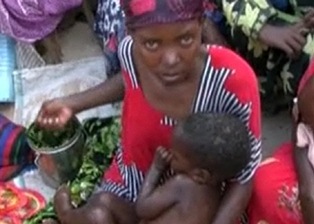 DOLO, Somalia (AP) -- Lush patches of green dot this once-barren land, allowing goats and camels to graze. A nearby field is full of large, purple onions thanks to a U.N.-funded project.
DOLO, Somalia (AP) -- Lush patches of green dot this once-barren land, allowing goats and camels to graze. A nearby field is full of large, purple onions thanks to a U.N.-funded project.
Four months after the U.N. declared famine in much of Somalia, some regions are beginning a slow recovery from a disaster that has killed tens of thousands of people. But some Somalis - women, mostly - living in a stick-hut camp in this border town say they won't return home because they're afraid of hardline Islamist militants stalking those parts of the country, and of being unable to feed themselves.
The U.N. last week reduced the number of famine zones in Somalia from six to three and said the number of people at risk of starvation has dropped from 750,000 to 250,000.
Since the July 20 famine declaration, the U.N. has received $800 million in aid. But the lives of 13 million people affected by East Africa's worst drought in decades remain in doubt. Officials say aid deliveries must continue or recovering regions will plunge back into famine.
"We are just at the beginning of a phase of a potential recovery if everything goes well," said Luca Alinovi, the head of the Somalia office of the U.N.'s Food and Agricultural Organization.
He said it will likely be a year before anyone is sure the danger has passed.
Drought wiped out much of Somalia's crops. Then herds of camels and goats perished, or were forced out of low-rain regions. The arrival of seasonal rains has pumped new life into Dolo, a river town on the Ethiopian border that's in an area that until last week was considered a famine zone.
Small herds of goats frolic near Dolo's yellow flowering bushes. Camels outside town munch on green shrubs. Donkeys drink puddles of muddy water. From the air, a spotty green canopy can be seen in place of the forbidding brown landscape that existed in July.
A camp on the edge of town is home to 5,000 people, mostly women and children, who fled the famine in other parts of Somalia. Somalis have also crowded into famine refugee camps in other parts of the country, including the capital, and outside the country, in Kenya and Ethiopia.
A local U.N. worker, Abdi Nur, said many of the men at the Dolo camp have returned home to plant crops. But many of the women say they won't join them.
"I don't want to go back," said Hafida Mamood, 62. "There's no security and no animals. We don't want to go anywhere. The food is here."
Other women nodded in agreement and voiced the same conviction.
Challiss McDonough, a World Food Program spokeswoman, said the displaced Somalis "have to feel physically secure and have a livelihood that will allow them to make ends meet" in their home regions.
Doubt remains, and a recent push by Kenyan forces into Somalia has complicated matters.
Somalia's famine has been made more severe by al-Shabab militants who control the country's south have impeded the work of some aid agencies, such as WFP. U.N. officials say tens of thousands of people have died, though Mark Bowden, the U.N.'s top humanitarian official for Somalia, said he does not believe there will ever be a precise toll.
Kenyan forces moved into southern Somalia last month to battle al-Shabab, and Bowden said some Somalis have fled that fighting. The military intervention is also preventing some food supplies from being delivered, he said.
Alinovi said the conflict could keep food production down, despite the new rains. This rainy season, if all goes well, will only supply about 30 percent of Somalia's food needs.
"Where conflict increases, farmers do not go to plant. They stay out of their field. If this happens things will get worse and worse," Alinovi said.
Kenya troops in Somalia are trying to move toward the al-Shabab-controlled port town of Kismayo, but their advance has been slowed by rain. Ethiopian troops over the last week have also moved into Somalia to attack militants.
Security is not a concern for the refugees in Dolo, which is under the de facto security umbrella of Ethiopia.
On the town's outskirts, Alinovi on Monday visited an FAO-funded irrigation project that has allowed a community of 20 families to plant and harvest 10 hectares of onions, tomatoes and maize - food that allowed the families to survive during the famine.
Big, purple onions lay in wet dirt. On the field's edge was a dusty generator that could fill the field's irrigation ditches with muddy river water in a matter of minutes. Keynan Ibrahim, a 20-year-old member of the farming project, cleared trees and bushes from the fields in early 2010 so food could be planted.
"We were not affected by the drought. We had enough food from the farm," he said.
Alinovi, doing a back-of-the-envelope calculation in the field of onions, said he thinks the FAO spent about $8,000 on the project, including labor money to clear the field, seeds, fertilizer, tools, the water pump and a generator.
FAO has nearly 250 such irrigation projects in Somalia, Alinovi said. He wishes he had money for more.
"They were able to continue to produce even during the drought. They've been selling their food ... and they didn't need any support from any others," he said, adding: "This is a very good example of what should be happening all across Somalia."
© 2011 The Associated Press. All rights reserved. This material may not be published, broadcast, rewritten or redistributed. Learn more about our Privacy Policy and Terms of Use.
- Home
- News
- Opinion
- Entertainment
- Classified
- About Us
 MLK Breakfast
MLK Breakfast- Community
- Foundation
- Obituaries
- Donate
04-18-2024 9:21 am • PDX and SEA Weather




















































































































































































































































































































